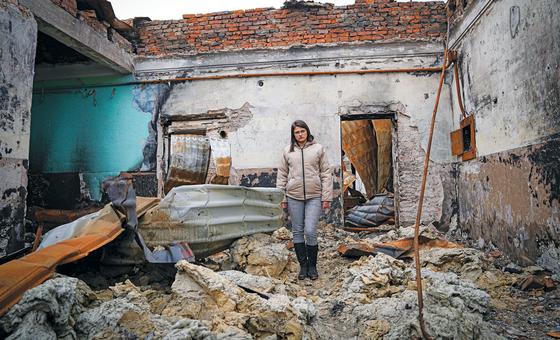
Briefing from Ukrainian capital Kyiv after another night of “air sirens and more loud explosions”, Mr. Schmale noted that the crisis began in 2014, with Russia’s illegal annexation of Crimea. “So, all children that were born since – all children up to the age of 11 – have never experienced their country at peace,” he said.
According to the UN aid coordination office, OCHA, 2024 saw a 30 per cent increase in civilian casualties compared to 2023. “The humanitarian situation is worsening, especially in frontline areas,” it said in an update, highlighting that a full 36 per cent of Ukraine’s population – 12.7 million people – needs humanitarian aid this year.
“There are very strong pushes by the armed forces of the Russian Federation along the front line and evacuations are ongoing,” Mr. Schmale explained. “We are supporting people with essential goods, including cash assistance, as they are on the move to transit centres, collective sites and wherever they end up being.”
Speaking from Zaporizhzhia in southeast Ukraine, Toby Fricker from the UN Children’s Fund (UNICEF) said that more than 2,520 children have been killed or injured since the start of the full-scale Russian invasion.
“The real number is likely far higher and it’s getting worse”, said Mr. Fricker, chief of communication in Ukraine. “There was a more than 50 per cent increase in child casualties in 2024 compared to 2023 and what we see is no place is safe: schools, maternity wards, children’s hospitals, all have been affected by attacks.”
Behind battle lines
Underscoring the essential role played by women in Ukraine “beyond the battlefield”, UN Women Geneva Director Sofia Calltorp explained that “there is another story unfolding, and that is the story of all those women and girls who are bearing the brunt of this war.”
In 2024, the number of people killed and injured in Ukraine increased by 30 per cent, Ms. Calltorp noted. “Of them, 800 women lost their lives and more than 3,700 women were injured last year in Ukraine. We also know that the vast majority of Ukrainian refugees and displaced persons are women, and 6.7 million women are in need of lifesaving humanitarian assistance.”
Funding crisis
Responding to questions about the impact of the US funding freeze on humanitarian work, Ukraine Humanitarian Coordinator Mr. Schmale expressed “hope that US funding will become part of the equation. Last year, it made up 30 per cent of what we spent on the humanitarian side, 10 per cent on the development side.”

Automatic Ad Middle Of Content
The UN’s top aid official in Ukraine added: “We are of course worried about the funding freezes; as we all know, it’s not the end of the day yet, there are a lot of discussions going on. We have some of our partners, including within the UN, that have received some exemptions from the general freeze of funding, but so far, no money has been flowing as a result of those exemptions.”
In addition to repeated attacks on energy infrastructure across Ukraine, other public facilities have also been targeted, with 780 health centres and more than 1,600 schools damaged or destroyed, according to the UN World Health Organization (WHO).
“In Odessa this week we saw a health clinic providing care for 40,000 children and a kindergarten serving 250 of the youngest children were severely damaged in an attack,” said Dr Jarno Harbicht, WHO Country Representative for Ukraine. “When a children’s hospital is hit, a school shelled or electric grid destroyed, children suffer even when they survive.”
Haunted by drones
The mental stress faced by millions of Ukrainians because of the war is real and debilitating, the WHO official continued: “Imagine a young mother in Kharkiv region in Ukraine, her days interrupted by air raid sirens and her nights haunted by drones. Each day is a struggle balancing her children’s safety with their anxiety that has become her constant companion.”
The UN Human Rights Monitoring Mission (HRMMU) has confirmed the killing of more than 12,654 civilian men, women, girls, and boys since the full-scale Russian invasion on 24 February 2022, with nearly 30,000 injured. Eighty-four per cent of the casualties happened in territory controlled by the Ukrainian government and 16 per cent in territory occupied by Russia.
“Three years of full-scale conflict in Ukraine have wrought persistent and escalating human rights violations and breaches of international humanitarian law,” said Danielle Bell, Chief of HRMMU. “As the civilian toll grows heavier, the human rights of all those affected must remain at the forefront of any negotiations for sustainable peace.”
Rising toll
The UN Human Rights Monitoring Mission (HRMMU) has confirmed the killing of more than 12,654 civilian men, women, girls, and boys since the full-scale Russian invasion on 24 February 2022, with nearly 30,000 injured. Eighty-four per cent of the casualties happened in territory controlled by the Ukrainian government and 16 per cent in territory occupied by Russia.
“Three years of full-scale conflict in Ukraine have wrought persistent and escalating human rights violations and breaches of international humanitarian law,” said Danielle Bell, Chief of HRMMU. “As the civilian toll grows heavier, the human rights of all those affected must remain at the forefront of any negotiations for sustainable peace.”
